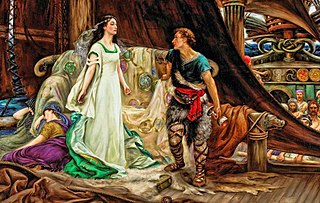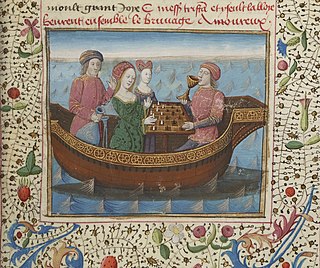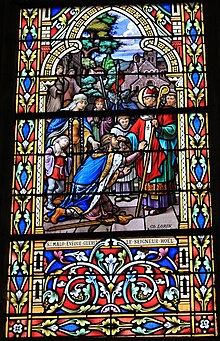
Hywel Dda, sometimes anglicised as Howel the Good, or Hywel ap Cadell was a king of Deheubarth who eventually came to rule most of Wales. He became the sole king of Seisyllwg in 920 and shortly thereafter established Deheubarth, and proceeded to gain control over the entire country from Prestatyn to Pembroke. As a descendant of Rhodri Mawr through his father Cadell, Hywel was a member of the Dinefwr branch of the dynasty. He was recorded as King of the Britons in the Annales Cambriæ and the Annals of Ulster.

Tristan, also known as Tristram or Tristain and similar names, is the hero of the legend of Tristan and Iseult. In the legend, he is tasked with escorting the Irish princess Iseult to wed Tristan's uncle, King Mark of Cornwall. Tristan and Iseult accidentally drink a love potion during the journey and fall in love, beginning an adulterous relationship that eventually leads to Tristan's banishment and death. The character's first recorded appearance is in retellings of British mythology from the 12th century by Thomas of Britain and Gottfried von Strassburg, and later in the Prose Tristan. He is featured in Arthurian legends, including the seminal text Le Morte d'Arthur, as a skilled knight and a friend of Lancelot.

Iseult, alternatively Isolde, is the name of several characters in the legend of Tristan and Iseult. The most prominent is Iseult of Ireland, the wife of Mark of Cornwall and the lover of Tristan. Her mother, the queen of Ireland, is also named Iseult. The third is Iseult of the White Hands, the daughter of Hoel of Brittany and the sister of Kahedin.
Hoël II was Count of Kernev, from 1058 as Hoël V. On the basis of his marriage to Hawise, Duchess of Brittany, in 1066, he became Duke of Brittany jure uxoris.

Cornouaille is a historical region on the west coast of Brittany in West France. The name is cognate with Cornwall in neighbouring Great Britain. This can be explained by the settlement of Cornouaille by migrant princes from Cornwall who created an independent principality founded by Rivelen Mor Marthou, and the founding of the Bishopric of Cornouaille by ancient saints from Cornwall. Celtic Britons and the settlers in Brittany spoke a common language, this language would evolve into Breton, Welsh and Cornish.

Mark of Cornwall was a king of Kernow (Cornwall) in the early 6th century. He is most famous for his appearance in Arthurian legend as the uncle of Tristan and the husband of Iseult, who engaged with Tristan in a secret liaison, giving Mark the epithet The Cuckold King.
Conan Meriadoc is a legendary Celtic leader credited with founding Brittany. Versions of his story circulated in both Brittany and Great Britain from at least the early 12th century, and supplanted earlier legends of Brittany's foundation. His story is known in two major versions, which appear in the Welsh text known as The Dream of Macsen Wledig, and in Geoffrey of Monmouth's Historia Regum Britanniae. Both texts associate him with Magnus Maximus, a Roman usurper against the Valentinianic dynasty who was widely regarded as having deprived Britain of its defences when he took its legions to claim the imperial throne. Conan's cousin or sister, Saint Elen, is said to have been Macsen Wledic's wife.

Tristan and Iseult is a chivalric romance retold in numerous variations since the 12th century, with a lasting impact on Western culture. The story is a tragedy about the illicit love between the Cornish knight Tristan (Tristram) and the Irish princess Iseult. It tells of Tristan's mission to escort Iseult from Ireland for marriage to his uncle, King Mark of Cornwall. On the journey home, the two of them ingest a love potion which brings about the adulterous relationship.

Brycheiniog was an independent kingdom in South Wales in the Early Middle Ages. It often acted as a buffer state between England to the east and the south Welsh kingdom of Deheubarth to the west. It was conquered and pacified by the Normans between 1088 and 1095, though it remained Welsh in character. It was transformed into the Lordship of Brecknock and later formed the southern and larger part of the historic county of Brecknockshire. To its south was the Kingdom of Morgannwg.

The Prose Tristan is an adaptation of the Tristan and Iseult story into a long prose romance, and the first to tie the subject entirely into the arc of the Arthurian legend. It was also the first major Arthurian prose cycle commenced after the widely popular Lancelot-Grail, which influenced especially the later portions of the Prose Tristan.
Sir Kahedin is brother to Iseult of Brittany and the son of King Hoel of Brittany in Arthurian legend. The story of his affair with Brangaine, the handmaiden of Iseult of Ireland is significantly mentioned in the Tristan and Iseult legend.
Brangaine is the handmaid and confidante of Iseult of Ireland in the Arthurian legend of Tristan and Iseult. She appears in most versions of the story.

Gwened, Bro-Gwened or Vannetais is a historic realm and county of Brittany in France. It is considered part of Lower Brittany.

Tristan and Iseult is a children's novel by Rosemary Sutcliff and was first published in 1971. A re-telling of the ancient legend, it received the Boston-Globe Horn Book Award in 1972, and was runner-up for the 1972 Carnegie Medal.
Budic II, formerly known as Budick, was a king of Cornouaille in Brittany in the late 5th and early 6th centuries. He was father of Hoel as well as several Celtic saints.

Poher is an ancient principality that emerged in the Early Middle Ages in Cornouaille in west-central Brittany. Its capital was the Gallo-Roman city of Vorgium, capital of the Osismii, which became Carhaix after the fall of the Roman Empire. Archaeological excavations scheduled since 1999 show that, even if the city lost its function as capital after the 4th century, it was nonetheless a stronghold and major strategic crossroads.
Alain Canhiart was the count of Cornouaille from 1020 to 1058. He was the son of Benoît de Cornouaille and the father of Hoël II, Duke of Brittany. His family name, Canhiart, is understood to be derived from the old Breton Kann Yac'h and was translated into the Latin texts of his era as Bellator fortis.
Tewdwr Mawr was an early medieval king in Armorica and Cornwall.
Alain II Hir, "Alain II the tall",, also known as Alan Hir was a king of Brittany who succeeded his father Iudicael as King of Cornouaille not to be confused with the contemporary Saint Iudicael King of Domnonee who was son of Iudhael King of Domnonee. He was the grandson of Hoel III King of Brittany and descended from Aldroen grandson of Cynan Meiriadog of the Welsh tale Breuddwyd Macsen Wledig via his son Gwereg the historical "Erec" from the Breton Romance Erec et Enid. He was the father of a supposed figure named Ifor who ruled Cornwall after reconquering it from the West Saxons who then left it to his nephew either Idwal Iwrch King of Gwynedd or his son Rhodri Molwynog King of the Britons as versions of the story vary, his daughter who in welsh genealogical manuscripts is either the mother or wife of Idwal Iwrch and possible mother of the aforementioned Rhodri Molwynog. According to Welsh tradition he was a 4th great nephew of Arthur by the marriage of Arthur's sister Elen to Hoel II of Brittany.
Judith of Nantes was titular Countess of Nantes from 1051 to her death in 1063.












